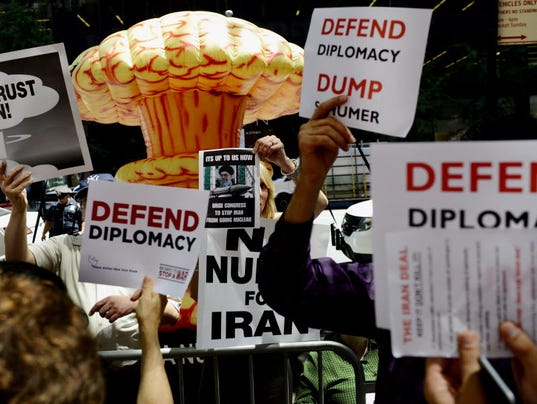 The opponents of the Iran deal are absolutely right about the existence of an alternative. We could bomb Iran. A sustained attack could destroy its nuclear facilities and presumably a large part of its stockpiled plutonium and highly enriched uranium. The Pentagon estimates that destruction of Iran’s current nuclear facilities would set back Iran’s weapons program by roughly two years, which is 18 months to 21 months longer than the current estimated break-out time of three months to six months with no deal.
The opponents of the Iran deal are absolutely right about the existence of an alternative. We could bomb Iran. A sustained attack could destroy its nuclear facilities and presumably a large part of its stockpiled plutonium and highly enriched uranium. The Pentagon estimates that destruction of Iran’s current nuclear facilities would set back Iran’s weapons program by roughly two years, which is 18 months to 21 months longer than the current estimated break-out time of three months to six months with no deal.
Here is what else the military option would get us. It would be a great gift to the terrorist group Islamic State, as we would be attacking its archenemy in the ongoing Sunni-Shiite struggles.
It would strengthen the hard-liners in Iran for the next generation, confirming what they have been saying for decades about the Great Satan and cutting the ground out from under younger and moderate voices who have been arguing for trading Iran’s illegal nuclear program for ending the sanctions and opening Iran up to the world again.
It would effectively declare war on Iran as an unprovoked military strike, which would then lead to Iranian retaliation through cyber and terrorist strikes on Americans and American territory. U.S. responses to those strikes could well drag us back into open war in the Middle East.
It would provide yet another recruiting video for terrorist groups throughout the Middle East and beyond, with pictures of U.S. jets bombing a Muslim nation to stop a program that nation’s government had just agreed to stop peacefully through diplomacy. The image of Cowboy America, guns blazing, would once again become an image of Outlaw America, walking away from a deal that we negotiated at the head of international coalition of nations because we preferred to shoot it out instead.
It would end any possibility of ever again assembling a global coalition of countries against Iran, as even many of our allies and other countries opposed to Iran’s quest for a nuclear weapon would nevertheless oppose our use of force without international authorization.
The hardest pill to swallow is the release of tens of billions of dollars to Iran as soon as it complies with the terms of the nuclear deal, as determined by the U.S. and its negotiating partners — the European Union , Germany, France, Great Britain , China and Russia. That means tens of billions of dollars that could flow to the terrorist groups Iran supports, such as Hezbollah , although remember that Iran is fighting against ISIL.
But here’s the dirty little secret. That money is Iran’s money. The world has frozen it because of Iran’s illegal pursuit of a nuclear weapon. If, in fact, Iran complies with the terms of this deal, stops pursuing a weapon and completely dismantles its nuclear supply chain, then it is entitled to recover the funds. As much as we might hate the idea of a richer Iran supporting terrorism, both American political parties and the world at large decided long ago that a nuclear Iran supporting terrorism would be worse.
Bombing Iran’s nuclear facilities is the only alternative to the deal that is on the table if we want to stop the ayatollahs and the Revolutionary Guard from producing nuclear weapons, as North Korea has done over the past decade. The op-ed pages and congressional hearing rooms are filled with proposals for a better deal: one that stops the Iranians from ever enriching uranium again, even for peaceful purposes; one that would deny them conventional arms for decades; one that would completely destroy their nuclear infrastructure and allow nuclear inspectors to roam the country at will.
Lots of better deals can be imagined. But none can be struck. All the fulminating about how we should have done better is just that: woulda, coulda, shoulda. George W. Bush ’s administration spent eight years just trying to get Iran to come to the table to negotiate, without success. In 2010, during my first year working as director of Policy Planning under Secretary of State Hillary Clinton , we thought we had a deal with the Iranians to ship most of their highly enriched uranium to Russia, but it promptly collapsed when the Iranian negotiators took it back to the supreme leader, Ayatollah Khamenei . And all the while, the Iranians moved from hundreds of centrifuges to about 20,000, of ever more sophisticated design. Their supply of highly enriched uranium, just one step away from the fuel needed for a bomb, went up and up.

